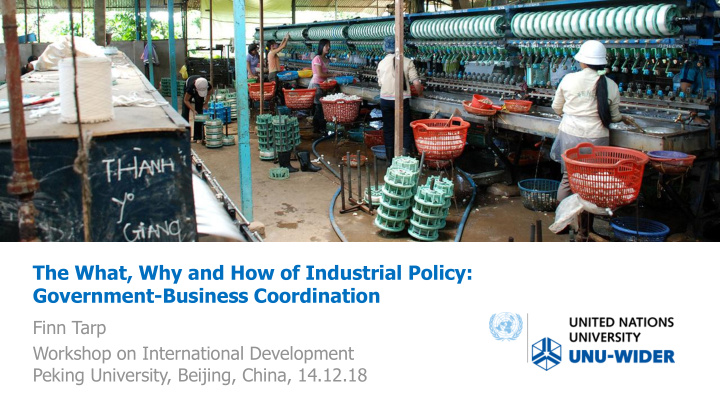



The What, Why and How of Industrial Policy: Government-Business Coordination Finn Tarp Workshop on International Development Peking University, Beijing, China, 14.12.18
Introduction A Major UNU-WIDER-Brookings Research Programme
WIDER’s 2014 -18 Research Programme • 3 Challenges – Transformation – Inclusion – Sustainability • 3 Concerns – Africa’s inclusive growth – Gender equity – Development finance • 3 Audiences – Decision-makers in developing countries – International agencies, both bilateral and multilateral – Global research community
Learning to Compete • We began with Learning to Compete (with AfDB) • Which tried to answer the question o Why is there so little industry in Africa?
About this presentation • Learning to Compete got us thinking about the why and how of industrial policy • And that led to research on government-business coordination in Africa and East Asia • This book is the basis for today’s remarks
The What
What: Conventional Wisdom • “Governments can’t pick winners” – It is impossible for governments to identify the relevant firms, sectors, or markets that are subject to market imperfections (Howard Pack) • “Government failures outweigh market failures” – Selective interventions are an invitation to corruption and rent- seeking (Anne Krueger) • Both of the above!
What: A Misdirected Debate • The debate about “picking winners” misses the point: governments make industrial policy on a daily basis via the budget, regulations and trade policy • In practice, most interventions, even those that are meant to be “horizontal”, favour some activities over others – Financial sector reforms favour larger, formal firms • The challenge is to find the right intervention
What: “Normalizing” Industrial Policy • As Dani Rodrik has pointed out, in other areas of policy making (macro for example) economists are willing to accept uncertainty and errors • For some reason this has been less true over the past 50 years with respect to industrial policy • But there is a welcome movement to “normalize” industrial policy and apply the same standards to it as to other economic policies
The Why
Why: The Market Place Is Not Magical • Market imperfections mean that the social returns in growth-promoting investments exceed private returns – This is a (neo)classic rationale for public action • Externalities and coordination failures call for a coherent strategy of public action • Both provide the rationale for industrial policy
Why: What you Make Matters • More diverse economies have better long run growth • Some economic activities have larger growth payoffs – Unconditional convergence in manufacturing • Economies with more sophisticated manufacturing sectors grow faster – “Sophisticated” products embody advanced country knowledge and productivity
The How
How: The Practice of Industrial Policy • Knowledge about spillovers, market failures and constraints that block structural change is diffused widely – Public inputs that producers require tend to be specific to the activity • Recent writing on industrial policy has emphasized the need for consultation and coordination with the private sector – Identify constraints, shape policies and monitor results
How: The Practice of Industrial Policy • Businesses have strong incentives to “game” (capture) the government • Balancing between coordination and capture is the key challenge of the practice of industrial policy
How: Government-Business Coordination • Coordination mechanisms have been used by all of the high performing East Asian economies • Countries differed in the form of coordination mechanisms – from “deliberation councils” (Japan, Korea) to local authorities (China, Vietnam) • All were designed to manage the tension between coordination and capture
How: Coordination in East Asia • Coordination mechanisms featured four elements: – A high level of commitment of senior government officials to the coordination agenda – Sharply focusing policy decisions and actions on specific constraints to firm performance – A striking willingness to experiment (public policy as pharmacology) – Careful attention to feedback
How: Rules, Referees and Rewards • East Asian countries used both incentives and discipline (carrots and sticks) – Subsidies were generous (rewards) – But they were conditioned on performance: especially on export performance (rules) • Making incentives conditional on export performance set up the right incentives for firms to increase their productivity
Government-Business Coordination in Africa
Government -Business Coordination in Africa • Efforts to achieve government-business coordination in Africa have been less successful • This reflects – An uneasy public-private partnership – Lack of coordination within government – Rewards without rules or referees
Strengthening Government-Business Coordination in Africa • High-level leadership is critical to success – In Ethiopia, Meles Zenawi, the late prime minister, was personally involved in the successful promotion of cut flowers. – President Museveni of Uganda signaled his commitment to its Presidential Investors’ Advisory Council (PIAC) by actively participating in meetings and following up on Council decisions – In Ghana President Kufour could not find time in his schedule to conduct a meeting of its Presidents Investors’ Council in more than two years • Commitment depends on getting things done which in turn depends on commitment
Summing-Up
Summing Up • The institutions that shape government – business relations are a key element of industrial policy • There is no single model of success of business – government coordination or industrial policy • The experience of successful coordination between the public and private sectors in Africa has been disappointing • However, with committed leadership, Africa can develop the institutions of public – private coordination • Look to Asian experiences for inspiration
www.wider.unu.edu Helsinki, Finland UNU-WIDER Youtube Channel youtube.com/user/UNUWIDER See also: econ.ku.dk/ftarp/
Recommend
More recommend